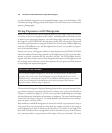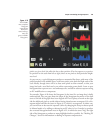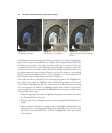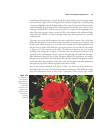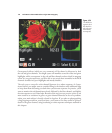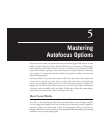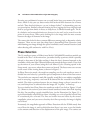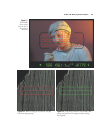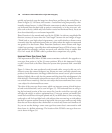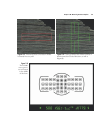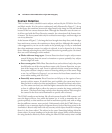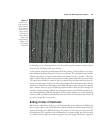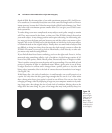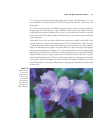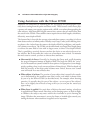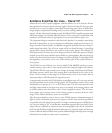quickly and precisely snap the image into sharp focus and line up the vertical lines, as
shown in Figure 5.3. Of course, this scenario—vertical lines being interpreted by a hor-
izontally oriented sensor—is ideal. When the same sensor is asked to measure focus for,
say, horizontal lines that don’t split up quite so conveniently, or, in the worst case, sub-
jects such as the sky (which may have neither vertical nor horizontal lines), focus can
slow down drastically, or even become impossible.
Phase Detection is the normal mode used by the D7000. As with any rangefinder-like
function, accuracy is better when the “base length” between the two images is larger.
(Think back to your high-school trigonometry; you could calculate a distance more
accurately when the separation between the two points where the angles were measured
was greater.) For that reason, Phase Detection autofocus is more accurate with larger
(wider) lens openings—especially those with maximum f/stops of f/2.8 or better—than
with smaller lens openings, and may not work at all when the f/stop is smaller than
f/5.6. As I noted, the D7000 is able to perform these comparisons very quickly.
Improved Cross-Type Focus Point
One improvement that Nikon D7000 owners sometimes overlook is the upgrade to a
cross-type focus point at 9 of the 39 center positions. Why is this important? It helps
to take a closer look at the Phase Detection system when presented with a non-ideal
subject.
Figure 5.4 shows the same weathered wood pictured earlier, except in this case we’ve
chosen to rotate the camera 90 degrees (say, because we want a vertically oriented com-
position). In the illustration, the image within the focus sensor’s area is split in two and
displaced slightly side-to-side, but the amount and direction of the misalignment is far
from obvious. A horizontally oriented focus sensor will be forced to look for less obvi-
ous vertical lines to match up. Our best-case subject has been transformed into a worst-
-case subject for a horizontal focus sensor.
The value of the cross-type focus sensor, which can interpret contrast in both horizon-
tal and vertical directions, can be seen in Figure 5.5. The horizontal lines are still giv-
ing the horizontal portion of the cross sensor fits, but the vertical bar can easily split
and align the subject to achieve optimum focus. Cross-type sensors can handle hori-
zontal and vertical lines with equal aplomb and, if you think about it, lines at any diag-
onal angle as well. In lower light levels, with subjects that were moving, or with subjects
that have no pattern and less contrast to begin with, the cross-type sensor not only works
faster but can focus subjects that a horizontal- or vertical-only sensor can’t handle at all.
So, you can see that having a center cross-type focus sensor that is extra-sensitive with
faster lenses is a definite advantage. The location of the D7000’s cross-type focus sen-
sors is shown in Figure 5.6.
David Busch’s Nikon D7000 Guide to Digital SLR Photography136



